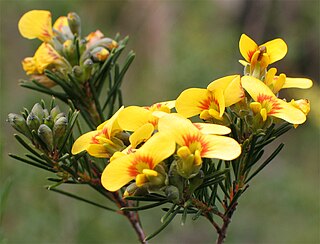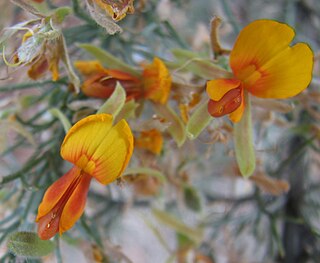
Pimelea, commonly known as rice flowers, is a genus of plants belonging to the family Thymelaeaceae. There are about 150 species, including 110 in Australia and 36 in New Zealand.

Persoonia, commonly known as geebungs or snottygobbles, is a genus of about one hundred species of flowering plants in the family Proteaceae. Plants in the genus Persoonia are shrubs or small trees usually with smooth bark, simple leaves and usually yellow flowers arranged along a raceme, each flower with a leaf or scale leaf at the base. The fruit is a drupe.

Baeckea is a genus of flowering plants in the myrtle family, Myrtaceae, all but one endemic to Australia. Plants in the genus Baeckea are shrubs or small trees with leaves arranged in opposite pairs, white to deep pink flowers with five sepals and five petals, and five to fifteen stamens that are shorter than the petals.

Dillwynia is a genus of about 20 species of flowering plants in the family Fabaceae, and is endemic to Australia. Plants in this genus are shrubs with simple leaves and yellow or red and yellow flowers similar to others in the family.

Chamelaucium, also known as waxflower, is a genus of shrubs endemic to south western Western Australia. They belong to the myrtle family Myrtaceae and have flowers similar to those of the tea-trees (Leptospermum). The most well-known species is the Geraldton wax, Chamelaucium uncinatum, which is cultivated widely for its large attractive flowers.

Philotheca is a genus of about fifty species of flowering plants in the family Rutaceae. Plants in this genus are shrubs with simple leaves arranged alternately along the stems, flowers that usually have five sepals, five petals and ten stamens that curve inwards over the ovary. All species are endemic to Australia and there are species in every state, but not the Northern Territory.

Gastrolobium is a genus of flowering plants in the family Fabaceae. There are over 100 species in this genus, and all but two are native to the south west region of Western Australia.

Mirbelia is a plant genus belonging to the family Fabaceae and is endemic to Australia, occurring in every mainland state except South Australia. Plants in the genus Mirbelia are prickly, perennial shrubs with simple, sometimes sharply-pointed leaves, or the leaves absent. The flowers are arranged singly or in groups in leaf axils or on the ends of branches, the sepals joined at the base with five teeth. The petals are usually red, orange, purplish or bluish and the fruit is an inflated pod.

Jacksonia is a genus of about 73 species of mostly leafless, broom-like shrubs or small trees in the flowering plant family Fabaceae. The genus is endemic to Australia and species occur in a range of habitats in all Australian states except Victoria, South Australia and Tasmania.

Xanthosia is a genus of flowering plants in the family Apiaceae and is endemic to Australia. It comprises 20 species of shrubs endemic to Australia. Plants in the genus Xanthosia are perennial herbs or small shrubs, the leaves divided, toothed or lobed,, the flowers white, pinkish or pale green and usually arranged in a compound umbel.

Hypocalymma is a genus of evergreen shrubs in the myrtle family Myrtaceae described as a genus in 1840. The entire genus is endemic to southern Western Australia.

Bossiaea is a genus of about 78 species of flowering plants in the pea family Fabaceae and is endemic to Australia. Plants in this genus often have stems and branches modified as cladodes, simple, often much reduced leaves, flowers with the upper two sepal lobes larger than the lower three, usually orange to yellow petals with reddish markings, and the fruit a more or less flattened pod.

Petrophile is a genus of evergreen shrubs, in the family Proteaceae. The genus is endemic to Australia. Commonly known as conebushes, they typically have prickly, divided foliage and produce prominently-displayed pink, yellow or cream flowers followed by grey, conical fruits.

Lasiopetalum, commonly known as velvet bushes, is a genus of about forty-five species of flowering plants in the family Malvaceae, all endemic to Australia.

Trachymene is a genus of herbaceous plants in the family Araliaceae. The species are native to Australia, Malesia, New Caledonia and Fiji.

Daviesia, commonly known as bitter-peas, is a genus of about 130 species of flowering plants in the family Fabaceae, and is endemic to Australia. Plants in the genus Daviesia are shrubs or small trees with leaves modified as phyllodes or reduced to scales. The flowers are arranged singly or in groups, usually in leaf axils, the sepals joined at the base with five teeth, the petals usually yellowish with reddish markings and the fruit a pod.

Calytrix is a genus of about 83 species of flowering plants, commonly known as star flowers, in the family Myrtaceae and is endemic to Australia. Plants in the genus Calytrix are small to large shrubs with small, spreading and more or less round leaves, the flowers arranged singly in leaf axils. The flowers are bisexual with 5 overlapping sepals with a long awn, and many stamens.

Sphaerolobium is a genus of flowering plants in the family Fabaceae and is endemic to Australia, occurring in all states and territories except the Northern Territory. Species of Sphaerolobium are erect shrubs, usually with rush-like stems and yellow or red flowers similar to others in the family.

Darwinia oxylepis, commonly known as Gillham's bell, is a plant in the myrtle family Myrtaceae. It grows as a dense, upright shrub 1.0–1.5 m (3.3–4.9 ft) high, and produces large numbers of red inflorescences prominently displayed on the ends of the branchlets in spring. It is one of a group of Darwinias including D. leiostyla, D. macrostegia, D. meeboldii, D. collina and D. squarrosa collectively known as mountain bells. The species is found in only a few seasonally moist gullies near the lower slopes of the Stirling Range National Park and nearby Porongurup National Park and is therefore classified as endangered.




























